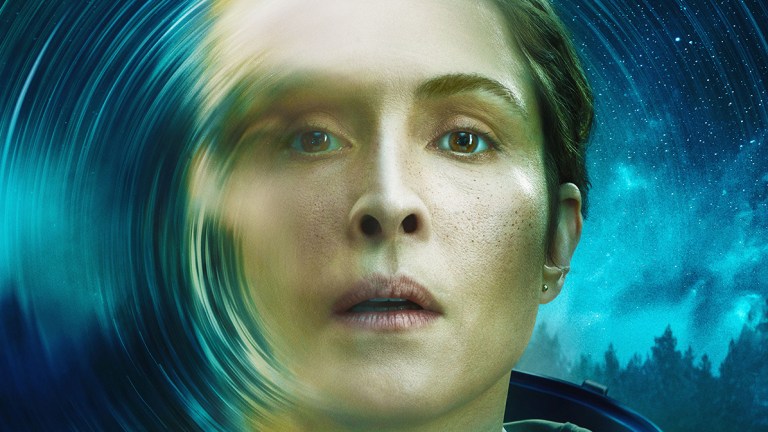Constellation’s Stupid Christmas Cracker Joke Unlocks Its Story
Reality A or B? Spoilers.

Warning: contains spoilers for Constellation episode four.
Nothing is wasted in Apple TV+ Constellation. Its story of an astronaut coming back from space a changed woman is a sci-fi puzzle that viewers are invited to solve, and clues to its mysteries are everywhere: in apparently trivial details, in paintings hanging on walls, in the title of a children’s book… and even in the silliest gag.
In episode four, recently returned astronaut Johanna Eriksson (Noomi Rapace) tries to assimilate back into life on Earth. Her husband Magnus and daughter Alice surprise her with a combined birthday and Christmas party, to catch up with the celebrations she missed while on her International Space Station mission. As part of the dinner, the English-Swedish family pull Christmas crackers and groan at the cheesy jokes they contain. Magnus reads:
“The Spanish fireman has two sons. What are they called? José and Hose B.”
It’s a bad pun, but one that, like the mention of Swedish fairy tale “The Changeling” in the same episode, feeds into Constellation’s uncanny story about people moving between realities.
Johanna and Bud’s Liminal State
Episodes one to three set up the mystery of why Johanna and 1970s NASA astronaut Bud Caldera, played by Jonathan Banks, are experiencing hallucinations after traumatic space missions. Why is Bud’s memoir apparently filled with inaccuracies about the most basic details of his early life, such as getting the name of his childhood dog wrong? Why does Johanna think the family car should be red and not blue? Why does her previously bilingual daughter now only speak English?
The answer lies in José and Hose B, or more specifically in Johanna A and Johanna B.
During Johanna’s mission, Bud masterminded a quantum physics experiment on board the ISS that aimed to find proof that the same particle could exist in two different states simultaneously. It found that proof, but frustratingly for Bud, he’s the only person who can see the positive result, because since returning from space, Bud and Johanna now exist in a liminal state shifting between two versions of reality. Those two are, essentially, the particles existing in two states at the same time.
The theory so far goes that their space missions altered them in such a way that allows them to now perceive two realities. Reality A, Reality B – and maybe more. They’re not the only ones either. Johanna’s sleuthing in episode four reveals a conspiracy that also involves past astronauts Amanda Klein and Sally Lynch, both of whom reported the same uncanny confusion on their return to Earth, and both of whom – like Johanna and Bud – were secretly drugged with anti-psychotic medication Lithium-7 in the guise of ‘vitamins’.
Johanna’s Conflicting Realities
In Reality A, which is unfamiliar to Johanna and where most of Constellation has been set so far, her mission led to the death of NASA scientist Paul Lancaster. Before she went to space, Johanna and Magnus’s marriage was floundering and she was having an affair with her ESA colleague Frederick. Daughter Alice speaks only English, the family car is blue, Johanna plays the piano and Finnish painter Hugo Simberg’s “The Wounded Angel” hangs on the wall of their remote holiday cabin.
In Reality B, which Johanna remembers and which is glimpsed periodically in Constellation, the mission led to Johanna’s death instead of Paul’s. She wasn’t having an affair with Frederick, daughter Alice spoke both Swedish and English, the family car was red, Johanna neither played nor owned a piano, and Hugo Simberg’s “The Poor Devil by the Fire” hangs on the wall of their remote holiday cabin, where Magnus takes Alice after Johanna’s funeral.
There also appears to be an overlapping Reality C, distinguished by a composite Hugo Simberg painting hanging in the remote holiday cabin in which the central figures from “The Poor Devil by the Fire” and “The Wounded Angel” have been swapped.
The Observer Effect
In episode four, Bud suggests in a discussion about The Observer Effect that it’s his brain chemistry that’s changed, causing his liminal existence:
“What if the results of the experiment could theoretically make themselves visible in different ways. Not on a screen, in the mind of an observer, what you see in the world around you. What if it works on the chemistry of the brain? The whole history of quantum physics is bound up with The Observer Effect, the effect that looking at something has upon the experiment. What if the experiment is having an effect on me?”
Why Does Alice See It Too?
Good questions, all. But after episode four, they leave viewers with a biggie: why, if something happened up in space to shift the brain chemistry of Bud, Johanna, Amanda, Sally (and possibly cosmonaut Irena Lysenko, whose alt-reality corpse may have collided with the ISS, causing the accident in episode one) making them experience a new version of their existing reality, does Alice also experience the reality shifts?
In episode four, Alice sees another version of herself at the funereal wake of her mother – the same mother who is alive and well and standing right in front of her. Johanna’s husband Magnus experiences no such shifts. If Alice has never been to space, then why is she experiencing the weird multiple realities too? Alice A or Alice B?
Constellation continues on Wednesday March 6 on Apple TV+
